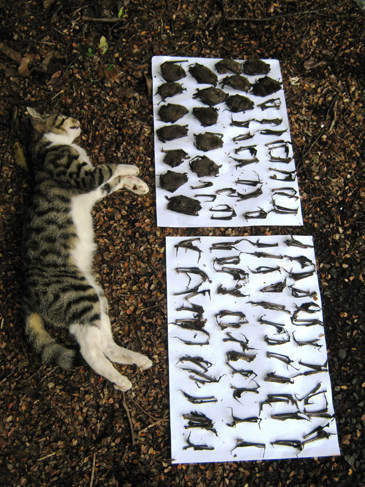The conversation about cats
Dear New Zealand,
It’s time we had the talk. You know the one? The one we’ve been putting off for aaages and aaaages because, well, because we love our pussycats in this country.
We have one of the highest cat ownership rates in the world, if not the highest. Almost half of all households in New Zealand have at least one cat, and 20 per cent have more than two. There are more than a million cats in the country – with little to no regulation or monitoring on them.
Don’t get me wrong, I’ve been part of the problem too. From Fluffy, to Smokey, Bart and Lisa – I have grown up with cats. Cats I’ve loved, dearly. But as I grew up, I realised I loved other things too. The things that make New Zealand so special. And as I learned to love these new things, I learned about their plight. I learned that New Zealand is a “land of birds”, with no native terrestrial mammals except for two tiny species of bat. I learned that our birds, reptiles and invertebrates had evolved for 80 million years in the absence of mammalian hunters, and that a veritable onslaught of introduced hunters had wiped out many species of birds, reptiles, a bat – and innumberable invertebrates. (Remember the story about the single cat that destroyed over a hundred endangered bats in the space of a week?)
I know many of you have cats, love your cats and don’t like it when people bring up the issue of cats and their impact on our native wildlife. I know there’ll be many people who’ll respond saying their cat doesn’t hunt, or only hunts rodents (and yes cats do kill plenty of rodents)… But it’s time we got real. I’m not saying you have to do anything, I’m simply saying let’s be realistic about what having cats means for our native wildlife.
Cats have been established in New Zealand for almost 200 years and right from the beginning their hunting prowess in our native bush was recorded; Cook noticed during his second voyage to Aotearoa in 1773 that the cat was often hunting in the forest.
The most famous example of a cat sending a species to extinction was the story of the Stephens Island wren, a tiny flightless bird that scuttled about like a mouse. In 1894, the lighthouse keeper’s cat Tibbles brought him one of these tiny birds. Within a year they had all disappeared – into cat bellies. From the moment of discovery to the time it took to get the bird specimen sent to London to be formally described, the Stephens Island wren was wiped off the planet. Contrary to popular belief, it wasn’t just down to Tibbles, but a number of cats that were ranging across the island at the time.
North Island saddleback, pied tit, tui and red-crowned parakeet were eliminated on Cuvier Island, off the Coromandel coast, mostly through predation by cats. A precious population of kakapo (including crucial females) was rediscovered on Stewart Island in 1977, free from stoats, ferrets and weasels – but easy prey to feral cats. By 1987, all remaining kakapo were evacuated off Stewart Island before they too were lost forever.
Today we have a bizarre situation where people think it is their “right” to have a cat (or many, many cats) with no licensing, registration or monitoring or rules, and bugger the wildlife. People around the world would find this attitude very strange.
My Aunty in Brisbane is one of the biggest cat lovers I know, but she also loves her wildlife (and she has plenty of it! A house surrounded by trees, parrots, parakeets, butcher birds, kangaroos, even the odd python). So at her house her cats live a fantastic life indoors with a catdoor to “outside”, which is a caged area. They get natural sunlight, a place to go to the toilet, but no chance to take a swipe at a passing cockatoo or other Aussie animal.
A couple of months ago, I made an offhand comment to a journalist that if you live in an area with lots of native wildlife, perhaps when your cat dies you might choose not to replace it. You would think I had committed the ultimate blasphemy! An afternoon of interviews followed, culminating in an appearance on Close Up that evening alongside a lady who was a cat lover (I think she had 10), but agreed with the suggestion that cats near wildlife areas weren’t a great idea. (I suspect the Close Up producers were gutted we were in agreement since they’d been trumpeting a “cat fight” between us in all the advertising preceding the interview.)
I had cats my whole childhood, but I choose not to have another one, because I really like my birdlife around the place. On the front page of the Dominion Post this week Zealandia staff have suggested the same thing in order to protect the birds that are starting to fly out of the sanctuary and take up residence in nearby backyards. Good suggestion. If you choose to live in a place spilling over with wildlife like Zealandia in Karori, why on earth would you have a cat? I’d rather have half a dozen kaka visiting, personally.
So New Zealand, I know we love our cats, but we love our wildlife too. Can we make some changes to give our wildlife a chance to thrive? A scientist friend suggest we microchip all of our cats, meaning we could keep tabs on domestic moggies and get rid of feral cats. Is this a way forward? I want to hear your suggestions too.
Yours faithfully,
Nicola (former cat owner, still a cat-liker, but more and more a native wildlife lover)
Please note: this blog has been re-published from the Stuff blog In our nature

